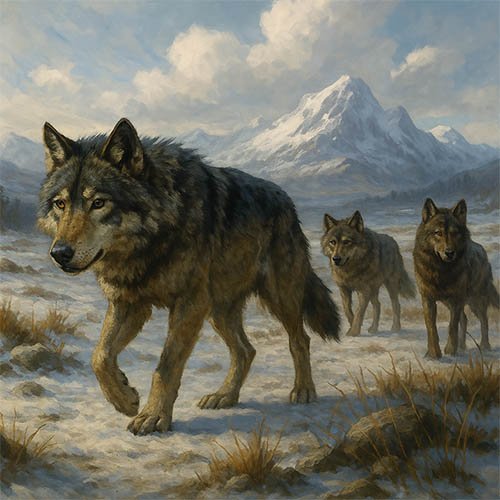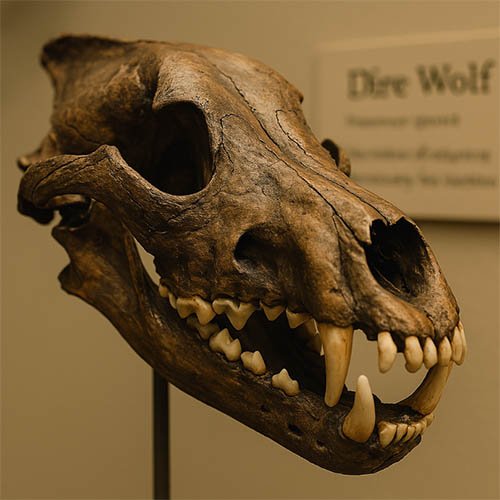🐺 Dire Wolves Return: What Science Says About These Ancient Beasts.
Have you ever pondered whether dire wolves, the fabled creatures from the Ice Age and beloved characters from fantasy television, may once again roam among us? The idea of a dire wolves return may sound like science fiction, but new research and findings have raised interest in the topic. This is all the information you require.

The Truth About Dire Wolves Return
🔍 What Were Dire Wolves?
Before we dive into how or why the dire wolves return is making headlines, let’s understand who these creatures were. During the Late Pleistocene, dire wolves (Canis dirus) roamed both North and South America. They had stronger jaws and teeth designed to shatter bone, and they were bigger and more muscular than gray wolves today.
Real dire wolves, in contrast to the mythical ones you may encounter in popular culture, were apex predators that hunted horses, bison, and even baby mammoths.

🧬 The DNA Finding That Revolutionized Everything
The “dire wolves return” theory was given new life following the publication of a ground-breaking study in 2021. By successfully removing genetic material from dire wolf bones, scientists have provided us with the most comprehensive understanding of their biology to date.
And what is startling? Gray wolves and dire wolves were not closely related, even if they looked alike. The evolutionary lineage from which they originated was entirely distinct from that of current dogs; it branched off millions of years ago and is now extinct.

“Read more about the study here: Nature Research on Dire Wolves“
This finding was significant because it altered the way scientists thought about the potential for a dire wolves return through selective breeding or cloning.
🧪 Is Cloning Possible?
Now comes the big question: Can we really bring them back?
The short answer: Not yet — but maybe someday.
It takes high-quality DNA and a closely related modern species to serve as a surrogate in order to clone ancient animals like the mammoth or the dire wolf. There’s no ideal fit when it comes to dire wolves. They have no genetic ties to coyotes, gray wolves, or dogs.
However, scientists haven’t ruled it out. Some believe that advanced gene-editing techniques like CRISPR may one day be used to produce a hybrid or altered animal with dire wolf characteristics.
As a result, both scientists and enthusiasts are keeping a close eye on every new development related to the dire wolves return.
“Learn more about cloning efforts: National Geographic – Animal Cloning”
🦴 Fossil Finds Fuel the Buzz Why is there so much hype right now?
In recent years, more dire wolf fossils have been unearthed — particularly in places like the La Brea Tar Pits in Los Angeles. These discoveries keep the topic of dire wolves return in the media and scientific conversations.
Visit: La Brea Tar Pits and Museum
Fossils give us critical insight into their diet, behavior, and even social structure. Some experts believe dire wolves hunted in packs, much like modern wolves, which adds to their mystique and the hope of one day seeing a dire wolves return to the wild — or at least in controlled environments.
🌍 Is It Safe to Have a Dire Wolves Return?
It gets complicated at this point. If the dire wolves return were biologically feasible, it could still be challenging to release them into modern environments. The Ice Age and our current planet are substantially different.
There are questions about:
What they would eat
How they’d interact with modern wildlife
Whether humans could safely coexist
For this reason, many scientists believe that if the dire wolves return ever happens, it would most likely be within research parks, zoos, or wildlife enclosures.
📺 The Part Pop Culture Plays in the Hype
The world’s fascination with these magnificent animals has undoubtedly been rekindled by fantasy television shows like Game of Thrones. The dire wolves return theory intrigues people for narrative as well as scientific reasons.
This popularity has also led to more funding and public interest in studying these ancient animals, which could ironically speed up the dire wolves return in some scientific form.
💭 Final Thoughts: Is the Dire Wolves Return Really Coming?
Although we haven’t arrived yet, we are now closer than ever.
With the discovery of fossils, advances in genetics, and sophisticated biotech technologies, the dire wolves return is no longer merely a pipe dream. Every year, the scientific possibility grows more intriguing.
They are still there in our DNA, museums, and imaginations for the time being. But if science has taught us anything, it’s to never say never.
Therefore, keep in mind that the dire wolves return is not simply a thing of the past; it could also be a part of our future.
You May Read:
7 Myths About Dog Bite Treatment: Understanding What Really Prevents Rabies


